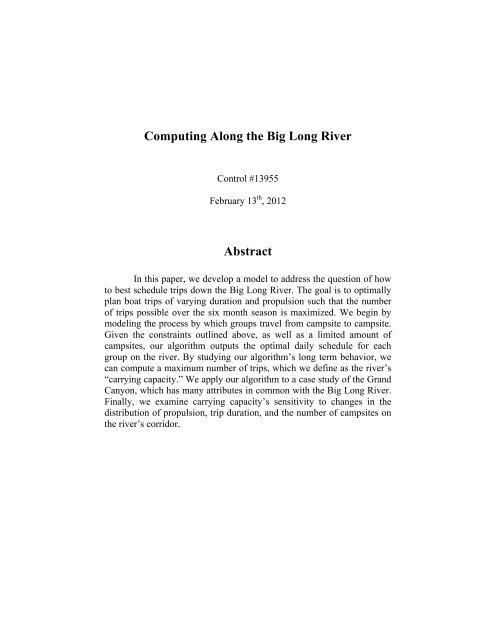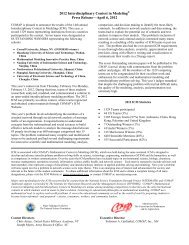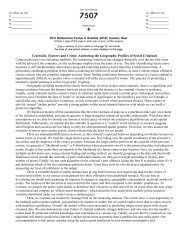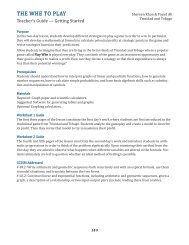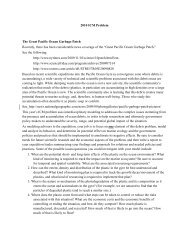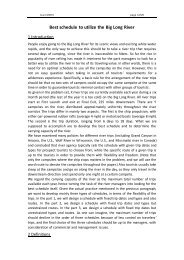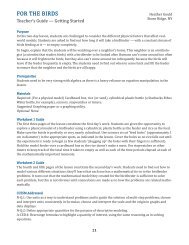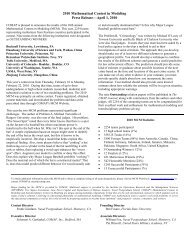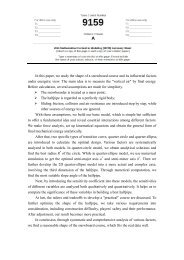Team 13955: Computing Along the Big Long River
Team 13955: Computing Along the Big Long River
Team 13955: Computing Along the Big Long River
You also want an ePaper? Increase the reach of your titles
YUMPU automatically turns print PDFs into web optimized ePapers that Google loves.
<strong>Computing</strong> <strong>Along</strong> <strong>the</strong> <strong>Big</strong> <strong>Long</strong> <strong>River</strong><br />
Control #<strong>13955</strong><br />
February 13 th , 2012<br />
Abstract<br />
In this paper, we develop a model to address <strong>the</strong> question of how<br />
to best schedule trips down <strong>the</strong> <strong>Big</strong> <strong>Long</strong> <strong>River</strong>. The goal is to optimally<br />
plan boat trips of varying duration and propulsion such that <strong>the</strong> number<br />
of trips possible over <strong>the</strong> six month season is maximized. We begin by<br />
modeling <strong>the</strong> process by which groups travel from campsite to campsite.<br />
Given <strong>the</strong> constraints outlined above, as well as a limited amount of<br />
campsites, our algorithm outputs <strong>the</strong> optimal daily schedule for each<br />
group on <strong>the</strong> river. By studying our algorithm’s long term behavior, we<br />
can compute a maximum number of trips, which we define as <strong>the</strong> river’s<br />
“carrying capacity.” We apply our algorithm to a case study of <strong>the</strong> Grand<br />
Canyon, which has many attributes in common with <strong>the</strong> <strong>Big</strong> <strong>Long</strong> <strong>River</strong>.<br />
Finally, we examine carrying capacity’s sensitivity to changes in <strong>the</strong><br />
distribution of propulsion, trip duration, and <strong>the</strong> number of campsites on<br />
<strong>the</strong> river’s corridor.
Page 2 of 18 Control #<strong>13955</strong><br />
Contents<br />
1 Introduction 3<br />
1.1 Defining <strong>the</strong> Problem . . . . . . . . . . . . . . . . . . . . . . . . . . . . . . . . . 3<br />
1.2 Model Overview . . . . . . . . . . . . . . . . . . . . . . . . . . . . . . . . . . . . 3<br />
1.3 Constraints . . . . . . . . . . . . . . . . . . . . . . . . . . . . . . . . . . . . . . 4<br />
1.4 Assumptions . . . . . . . . . . . . . . . . . . . . . . . . . . . . . . . . . . . . . 4<br />
1.5 Variables . . . . . . . . . . . . . . . . . . . . . . . . . . . . . . . . . . . . . . . 5<br />
2 Methods 6<br />
2.1 The Fur<strong>the</strong>st Empty Campsite. . . . . . . . . . . . . . . . . . . . . . . . . . . . . 6<br />
2.2 Priority . . . . . . . . . . . . . . . . . . . . . . . . . . . . . . . . . . . . . . . . . 7<br />
2.3 Priorities & O<strong>the</strong>r Considerations. . . . . . . . . . . . . . . . . . . . . . . . . . . 8<br />
3 Scheduling Simulation 10<br />
4 Case Study 12<br />
4.1 The Grand Canyon . . . . . . . . . . . . . . . . . . . . . . . . . . . . . . . . . . .12<br />
4.2 Sensitivity Analysis of Carrying Capacity With Respect to R and D . . . . . . . . . 13<br />
4.3 Sensitivity Analysis of Carrying Capacity With Respect to R and Y . . . . . . . . . 15<br />
5 Discussion & Conclusion 15<br />
6 Limitations and Error Analysis 16<br />
6.1 Carrying Capacity Overestimation . . . . . . . . . . . . . . . . . . . . . . . . . . . 16<br />
6.2 Environmental Concerns . . . . . . . . . . . . . . . . . . . . . . . . . . . . . . . 16<br />
6.3 Neglect of <strong>River</strong> Speed . . . . . . . . . . . . . . . . . . . . . . . . . . . . . . . . . 16<br />
7 References 17<br />
List of Figures<br />
Figure 2.1 Example – applying priority & <strong>the</strong> scheduling algorithm . . . . . . . . . . . . . 7<br />
Figure 2.2 Example – applying priority & <strong>the</strong> scheduling algorithm . . . . . . . . . . . . . 7<br />
Figure 2.3 Example – applying priority & <strong>the</strong> scheduling algorithm . . . . . . . . . . . . . 8<br />
Figure 2.4 Visual depiction of scheduling algorithm . . . . . . . . . . . . . . . . . . . . . 9<br />
Figure 3.1 Hypo<strong>the</strong>tical simulation . . . . . . . . . . . . . . . . . . . . . . . . . . . . . . .10<br />
Figure 3.2 Hypo<strong>the</strong>tical simulation results (from Figure 3.1) . . . . . . . . . . . . . . . . . 11<br />
Figure 3.3 Hypo<strong>the</strong>tical simulation results (From Figure 3.1) . . . . . . . . . . . . . . . . . 11<br />
Figure 4.1 Grand Canyon case study results from simulation. . . . . . . . . . . . . . . . . 12<br />
Figure 4.2 Ratio R to number of campsites Y . . . . . . . . . . . . . . . . . . . . . . . . . 13<br />
Figure 4.3 Contour representation of Figure 4.2 . . . . . . . . . . . . . . . . . . . . . . . . 14<br />
Figure 4.4 Ratio R to variation of trip days D . . . . . . . . . . . . . . . . . . . . . . . . . 15
Page 3 of 18 Control #<strong>13955</strong><br />
1 Introduction<br />
Scheduling trips is an important task for <strong>the</strong> tourism industry, but <strong>the</strong> matter of scheduling is<br />
also one of <strong>the</strong> more challenging problems to tackle. Airline companies juggle countless planes,<br />
destinations, passengers and times of day to try to best optimize <strong>the</strong>ir costs as well as how many people<br />
<strong>the</strong>y are able to transport. Computer systems manage limited resources, multiple jobs, ‘due dates’ and<br />
prioritization of jobs in order to function as a powerful and useful tool. Similar to <strong>the</strong>se examples, river<br />
managers have to be able to schedule river trips based on some of <strong>the</strong>se same constraints while striving<br />
to maximize <strong>the</strong> number of trips possible over a given time period.<br />
The contents of this paper address <strong>the</strong> <strong>Big</strong> <strong>Long</strong> <strong>River</strong>, and our devised method of addressing<br />
<strong>the</strong> issue of scheduling an optimal amount of trips per season. At 225 miles in length from First Launch<br />
to Final Exit, passengers take oar-powered rubber rafts and motorized boats downstream. Trips last<br />
between 6 and 18 nights, with tourists spending nights at campsites along <strong>the</strong> river corridor. To ensure<br />
that campers enjoy a wilderness experience, it is desired that at most one group occupy any given<br />
campsite each night. This constraint limits <strong>the</strong> number of possible trips during <strong>the</strong> park’s six month<br />
season.<br />
After <strong>the</strong> analysis of our model, we compare our results to rivers that have similar attributes to<br />
that of <strong>the</strong> <strong>Big</strong> <strong>Long</strong> <strong>River</strong>, allowing us to verify that <strong>the</strong> approach does in fact yield desirable results.<br />
In addition to this report we have attached a memo for <strong>the</strong> managers of <strong>the</strong> river. In <strong>the</strong> memo we<br />
address <strong>the</strong> topics in which <strong>the</strong>y were seeking advice, which consists of ways in which to develop <strong>the</strong><br />
best schedule for <strong>the</strong> river, and ways to determine <strong>the</strong> carrying capacity of <strong>the</strong> river.<br />
Models focused on producing solutions to scheduling problems are quite complex. They must<br />
be customized to address a vast number of variables in order to produce results subject to many<br />
constraints. We have developed a model which speaks specifically to <strong>the</strong> constraints outlined thus far<br />
and introduce what we believe to be reasonable assumptions in order to address <strong>the</strong> specific problem at<br />
hand. With that said, our model is easily adaptable to find optimal trip schedules for rivers of varying<br />
length, numbers of campsites, trip durations, and boat propulsions.<br />
1.1 Defining <strong>the</strong> Problem<br />
●<br />
●<br />
●<br />
How should trips of varying length and propulsion be scheduled to maximize <strong>the</strong> number trips<br />
possible over a six month season?<br />
How many new groups can start a river trip on any given day?<br />
What is <strong>the</strong> carrying capacity of <strong>the</strong> river?<br />
○ We define carrying capacity as <strong>the</strong> maximum number of groups which can be sent down<br />
<strong>the</strong> river during its six month season.<br />
1.2 Model Overview<br />
We have designed a model which:<br />
• Can be applied to real-world rivers with similar attributes (i.e. <strong>the</strong> Grand Canyon).<br />
• Is flexible enough to simulate a wide range of feasible inputs.
Page 4 of 18 Control #<strong>13955</strong><br />
• Simulates river trip scheduling as a function of some distribution of trip lengths (ei<strong>the</strong>r 6, 12, or<br />
18 days), a varying distribution of propulsion, and a varying number of campsites.<br />
Ultimately, <strong>the</strong> model predicts <strong>the</strong> number of successful trips in a six month time frame. As a<br />
result of finding this number, we also answer questions about <strong>the</strong> carrying capacity of <strong>the</strong> river,<br />
advantageous distributions of propulsion and trip lengths, how many groups can start a river trip each<br />
day, and how to schedule trips in such a way that <strong>the</strong>se results are possible.<br />
1.3 Constraints<br />
The problem specifies <strong>the</strong> following constraints:<br />
• Trips begin at First Launch and end at Final Exit – exactly 225 miles downstream.<br />
• There are only two types of boats: oar-powered rubber rafts and motorized boats.<br />
• Oar-powered rubber rafts travel 4 mph on average.<br />
• Motorized boats travel 8 mph on average.<br />
• Group trips will range from 6 to 18 nights.<br />
• Trips are only scheduled during a six month period of <strong>the</strong> year.<br />
• Campsites are distributed uniformly throughout <strong>the</strong> river corridor.<br />
• No two sets of campers can occupy <strong>the</strong> same site at <strong>the</strong> same time.<br />
1.4 Assumptions<br />
• We have <strong>the</strong> ability to determine <strong>the</strong> proportion of oar-powered river rafts to motorized boats<br />
that go onto <strong>the</strong> river each day.<br />
Moving a high volume of groups down <strong>the</strong> river in a satisfactory time becomes an issue<br />
if too many oar-powered boats are launched with short trip lengths.<br />
• The duration of trips is constrained to <strong>the</strong> following values: 12 or 18 days for groups travelling<br />
by oar-powered river rafts, and 6 or 12 days for those travelling by motorized boat.<br />
This is a simplification which allows our model to produce more meaningful results<br />
while preserving <strong>the</strong> ability to compare <strong>the</strong> effect of varying inputs.<br />
• There can only be one group per campsite per night.<br />
Our algorithm only considers campsites which are empty as open campsites that groups<br />
can move to, which is consistent with <strong>the</strong> desires of <strong>the</strong> river manager.<br />
• Each day, groups may only move downstream or remain in <strong>the</strong>ir current campsite -- <strong>the</strong>y may<br />
not move back up stream.<br />
This allows us to restrict <strong>the</strong> flow of groups on <strong>the</strong> river to a single direction which<br />
greatly simplifies <strong>the</strong> ways in which we can move groups from campsite to campsite.<br />
• Groups heading downstream can only travel <strong>the</strong> river between 8am and 6pm.<br />
This amounts to a maximum of 9 hours of travel per day (one hour is subtracted for<br />
breaks/lunch/etc.). This implies that oar-powered river raft groups can travel at most 36 miles
Page 5 of 18 Control #<strong>13955</strong><br />
per day, and motorized boats can travel at most 72 miles per day. This allows us to determine<br />
<strong>the</strong> set of groups that can reasonably reach a given campsite.<br />
• Groups will never travel fur<strong>the</strong>r than <strong>the</strong> amount of miles that <strong>the</strong>y can feasibly travel in a<br />
single day.<br />
As <strong>the</strong> previous assumption states, this is 36 miles per day for oar-powered river rafts<br />
and 72 miles per day for motorized boats in our model.<br />
• Variables which could influence maximum daily travel distance, such as wea<strong>the</strong>r and river<br />
conditions, are ignored.<br />
There is no way of accurately including this in <strong>the</strong> model with <strong>the</strong> amount of given<br />
information about <strong>the</strong> <strong>Big</strong> <strong>Long</strong> <strong>River</strong>.<br />
• Campsites are distributed uniformly so that <strong>the</strong> distance between campsites is 225/Y (<strong>the</strong><br />
length of <strong>the</strong> river divided by <strong>the</strong> number of camp sites between <strong>the</strong> start and end of <strong>the</strong> river).<br />
This assumption allows us to easily represent <strong>the</strong> river as an array of campsites that are<br />
equally spaced out in our computer simulation.<br />
• A group must reach <strong>the</strong> end of <strong>the</strong> river on <strong>the</strong> final day of its trip:<br />
o A group will not leave <strong>the</strong> river early even if <strong>the</strong>y are able to.<br />
o A group will not have a finish date that is past <strong>the</strong>ir desired trip length.<br />
This is an assumption that was made to best fit what we believed was an important<br />
standard for <strong>the</strong> river manager and <strong>the</strong> quality of <strong>the</strong> trips that <strong>the</strong>y will be scheduling.<br />
1.5 Variables<br />
• g ! = group number i <br />
• t ! = total trip length for group i, measured in nights where 6 ≤ t ≤ 18 <br />
• d ! = number of nights group i has spent on <strong>the</strong> river <br />
• Y = number of campsites on <strong>the</strong> river <br />
• c ! = location of campsite Y in miles downstream 0 < c ! < 225 <br />
• c ! = a campsite representing First Launch (used to construct a waitlist of groups) <br />
• c !"#$% = a campsite representing Final Exit (which is always ‘open’) <br />
• l ! = location of group i's current campsite in miles down <strong>the</strong> river, where 0 < l < 225 <br />
• a ! = average distance that group i should move each day to be on schedule (a ! = 225 t ! ) <br />
• m ! = maximum distance that group i can travel in a single day <br />
● P ! = priority of group i (where P ! = d ! t ! l ! 225 > 0) <br />
This is a measure of how far ahead or behind schedule a group is. We will define priority P as<br />
follows: <br />
○ P ! > 1 implies that group g ! is behind schedule <br />
○ P ! < 1 implies that group g ! is ahead of schedule <br />
○ P ! = 1 implies that group g ! is precisely on schedule <br />
● G ! = set of groups that can reach campsite c <br />
● R = <strong>the</strong> ratio of oar powered river rafts to motorized boats launched each day <br />
● X = <strong>the</strong> current number of trips down <strong>Big</strong> <strong>Long</strong> <strong>River</strong> each year
Page 6 of 18 Control #<strong>13955</strong><br />
●<br />
●<br />
M = peak carrying capacity of <strong>the</strong> river (maximum number of groups which can be sent down<br />
<strong>the</strong> river during its six month season) <br />
D = distribution of trip durations of groups on <strong>the</strong> river <br />
2 Methods<br />
Below is a description of <strong>the</strong> scheduling algorithm and, ultimately, our model which we have<br />
found to be representative of accurate results based on <strong>the</strong> various inputs and assumptions specified<br />
above. We begin by defining <strong>the</strong> following terms and phrases in an effort to add clarity to how certain<br />
variables are handled in our simulation, as well as to shed light on some of <strong>the</strong> details of <strong>the</strong><br />
implementation of our model:<br />
Open Campsite:<br />
A campsite is considered to be an open campsite if <strong>the</strong>re is no group currently occupying that<br />
space. This is equivalent to saying that for a given campsite c ! <strong>the</strong>re exists no o<strong>the</strong>r group g ! such that<br />
g ! is assigned to c ! .<br />
Moving to an open campsite:<br />
For a group g ! and a campsite c ! , moving to an open campsite is equivalent to assigning g ! to<br />
a new campsite, c ! . Since a group is only able to move downstream, or remain at <strong>the</strong>ir current<br />
campsite, if g ! was previously occupying c ! , <strong>the</strong>n g ! can only be moved to a c ! where m ≥ n.<br />
Waitlist:<br />
The waitlist for a given day is composed of <strong>the</strong> groups which are not yet on <strong>the</strong> river, but will<br />
start <strong>the</strong>ir trip on day where <strong>the</strong>ir ranking on <strong>the</strong> waitlist and <strong>the</strong>ir ability to reach a campsite, c,<br />
includes <strong>the</strong>m in <strong>the</strong> set G ! , and is deemed ‘<strong>the</strong> highest priority’ (Note: priority is a significant element<br />
of our model. This will be explained in fur<strong>the</strong>r detail a little later). Waitlisted groups are initialized with<br />
a current campsite value of c ! (<strong>the</strong> zero th campsite), and are assumed to have priority P = 1 until <br />
<strong>the</strong>y are moved from <strong>the</strong> waitlist onto <strong>the</strong> river. <br />
Off <strong>the</strong> <strong>River</strong>:<br />
Our algorithm considers <strong>the</strong> first space off of <strong>the</strong> river to be <strong>the</strong> ‘final campsite’, c !"#$% . For our<br />
model, we consider c !"#$% to always be an open campsite, so that an infinite number of g ! can be<br />
assigned to c !"#$% . This is consistent with <strong>the</strong> understanding that any number of groups can move off of<br />
<strong>the</strong> river in a single day, and allows us to handle such an event in our simulation.<br />
2.1 The Fur<strong>the</strong>st Empty Campsite<br />
Our scheduling algorithm utilizes an array as a data structure to represent <strong>the</strong> river, where each<br />
element of <strong>the</strong> array consists of a campsite. The algorithm begins each day by finding <strong>the</strong> open<br />
campsite that is fur<strong>the</strong>st down <strong>the</strong> river, call that campsite c, <strong>the</strong>n generates a set G ! , which consists of<br />
all groups g ! which could potentially reach campsite c. Thus,<br />
G ! = g ! | g ! , g ! , … , g ! ∶ where m ! + l ! ≥ c
Page 7 of 18 Control #<strong>13955</strong><br />
A couple of points about G ! remain to be made:<br />
(1) The requirement of m ! + l ! ≥ c specifies that group g ! must be located at l ! and that must be<br />
within at least m ! miles of campsite c.<br />
(2) G ! can consist of groups that are both on <strong>the</strong> river and on <strong>the</strong> waitlist.<br />
(3) If G ! = ∅, <strong>the</strong>n we move to <strong>the</strong> next fur<strong>the</strong>st empty campsite (Note: <strong>the</strong> next fur<strong>the</strong>st empty<br />
campsite that we look for is located up stream, closer to <strong>the</strong> start of <strong>the</strong> river – <strong>the</strong> algorithm<br />
always runs from <strong>the</strong> end of <strong>the</strong> river, up towards <strong>the</strong> start of <strong>the</strong> river).<br />
(4) If G ! ≠ ∅, <strong>the</strong>n <strong>the</strong> algorithm will attempt to move <strong>the</strong> group with <strong>the</strong> highest priority to<br />
campsite c. (For more instruction on this, see section 2.2: Priority).<br />
The scheduling algorithm continues in this fashion until <strong>the</strong> fur<strong>the</strong>st empty campsite is <strong>the</strong> zero th<br />
campsite, c ! . At this point, every group that was able to move on <strong>the</strong> river that day has been moved to a<br />
campsite, and we start <strong>the</strong> algorithm again from <strong>the</strong> beginning to simulate <strong>the</strong> next day.<br />
2.2 Priority<br />
As noted in <strong>the</strong> last section, once <strong>the</strong> set G has been formed for a specific c, our algorithm must<br />
decide which gεG to move to c. For this reason, we have developed <strong>the</strong> notion of priority for a group.<br />
Then we essentially look at <strong>the</strong> priority of each gεG, take <strong>the</strong> g ! with <strong>the</strong> highest priority, and <br />
attempt to move that group into c. <br />
Some examples of situations that arise, and how <strong>the</strong> notion of priority is used to resolve <strong>the</strong>m, are<br />
outlined in Figures 2.1 & 2.2.<br />
Campsite #: 1 2 3 4 5 6<br />
Group<br />
Assigned:<br />
Downstream→<br />
Group A<br />
P ! = 1.1<br />
Group B<br />
P ! = 1.5<br />
(moves to<br />
campsite 6)<br />
Group C<br />
P ! = .8<br />
Open Open Fur<strong>the</strong>st<br />
Open<br />
Campsite<br />
Figure 2.1: By running <strong>the</strong> scheduling algorithm we have found that fur<strong>the</strong>st open campsite is campsite<br />
6. The algorithm has found that Groups A, B and C can feasibly reach campsite 6. The priority of each<br />
group is calculated, and Group B has <strong>the</strong> highest priority; thus, we move Group B to campsite 6.<br />
Campsite #: 1 2 3 4 5 6<br />
Group Group A<br />
Assigned: P ! = 1.1<br />
(moves to<br />
campsite 5)<br />
Downstream→<br />
Open<br />
Group C<br />
P ! = .8<br />
Open<br />
Fur<strong>the</strong>st<br />
Open<br />
Campsite<br />
Group B
Page 8 of 18 Control #<strong>13955</strong><br />
Figure 2.2: As <strong>the</strong> scheduling algorithm progresses past campsite 6, we find that <strong>the</strong> next fur<strong>the</strong>st open<br />
campsite is campsite 5. The algorithm has calculated that Groups A and C can feasibly reach campsite<br />
5. Since P ! >P ! , group A is moved to campsite 5.<br />
2.3 Priorities & O<strong>the</strong>r Considerations<br />
By knowing <strong>the</strong> group priority, our algorithm will always try to move <strong>the</strong> group that is <strong>the</strong> most<br />
behind schedule. This is to ensure that each group is camping on <strong>the</strong> river for a number of days equal to<br />
its predetermined trip length. However, in some instances it may not be ideal to move <strong>the</strong> g ! ∈ G which<br />
has <strong>the</strong> highest priority to <strong>the</strong> campsite c which is <strong>the</strong> fur<strong>the</strong>st empty campsite. Such is <strong>the</strong> case if g !<br />
∈ G is <strong>the</strong> element with <strong>the</strong> highest priority, yet it is still ahead of schedule (P ! < 1).<br />
To address <strong>the</strong> various caveats of handling group priorities in our scheduling algorithm, we<br />
provide <strong>the</strong> following rules:<br />
(1) If g ! is behind schedule, i.e. P ! > 1, <strong>the</strong>n move g ! to c.<br />
(2) If g ! is ahead of schedule, i.e. P ! < 1, <strong>the</strong>n compute <strong>the</strong> following: d ! ∗ a ! . If <strong>the</strong> result is <br />
greater than or equal to <strong>the</strong> location of campsite c (in miles), <strong>the</strong>n move g ! to c. This<br />
amounts to only moving g ! in such a way that it is no longer ahead of schedule.<br />
(3) Regardless of P ! , if <strong>the</strong> chosen c = c !"#$% , <strong>the</strong>n it will not move g ! → c unless t ! = d ! . This<br />
ensures that trips will not end before <strong>the</strong>ir designated end date.<br />
Campsite #: 170 171<br />
…<br />
223 224 Off <strong>the</strong> <strong>River</strong><br />
Group<br />
Assigned:<br />
Group D:<br />
P ! = 1.1<br />
t ! = 12<br />
d ! = 11<br />
(doesn't<br />
move off <strong>the</strong><br />
river)<br />
Downstream→<br />
Open Open Open Open Fur<strong>the</strong>st Open<br />
Campsite<br />
Figure 2.3: The fur<strong>the</strong>st open campsite is <strong>the</strong> campsite that is off of <strong>the</strong> river. The algorithm finds that<br />
Group D could move <strong>the</strong>re, but since Group D has t ! > d ! , group D remains on <strong>the</strong> river.
Page 9 of 18 Control #<strong>13955</strong><br />
Figure 2.4: Visual depiction of scheduling algorithm.
Page 10 of 18 Control #<strong>13955</strong><br />
3 Scheduling Simulation<br />
We will now use our model to briefly demonstrate how it could be used to schedule river trips.<br />
In <strong>the</strong> following example, we assume <strong>the</strong>re are 50 campsites along <strong>the</strong> 225 mile river, and introduce 4<br />
groups to <strong>the</strong> river each day. We project <strong>the</strong> trip schedules of four specific groups, which we introduce<br />
to <strong>the</strong> river on day 25. We choose a midseason date to demonstrate our models stability over time:<br />
g ! : Motorized boat, t ! = 6<br />
g ! : Oar-powered river raft, t ! = 18<br />
g ! : Motorized boat, t ! = 12<br />
g ! : Oar-powered river raft, t ! = 12<br />
Campsite numbers and priority values for each group<br />
Number of nights spent on river<br />
g ! P ! g ! P ! g ! P ! g ! P !<br />
1 5 1.43 2 1.32 3 1.28 1 3.85 <br />
2 20 0.71 6 0.87 19 0.4 8 0.96 <br />
3 20 1.07 6 1.32 19 0.61 8 1.44 <br />
4 36 0.79 13 0.81 19 0.81 15 1.02 <br />
5 36 0.99 13 1.01 19 1.01 15 1.28 <br />
6 49 0.87 13 1.21 35 0.66 23 1 <br />
7 OFF 1 13 1.42 35 0.77 25 1.08 <br />
8 13 1.66 35 0.88 32 0.96 <br />
9 15 1.58 35 0.99 32 1.08 <br />
11 23 1.14 35 1.1 39 0.99 <br />
12 30 0.96 49 0.86 39 1.08 <br />
13 30 1.05 49 0.94 46 1 <br />
14 30 1.14 OFF 1 OFF 1 <br />
15 36 1.02 <br />
16 36 1.1 <br />
17 44 0.96 <br />
18 44 1.02 <br />
19 44 1.01 <br />
20 OFF 1 <br />
Figure 3.1: Shows each group’s campsite number and priority value for each night spent on <strong>the</strong> river.<br />
I.e. <strong>the</strong> column labeled g ! gives campsite numbers for each of <strong>the</strong> nights of g ! ’s trip.<br />
We find that each g ! is off <strong>the</strong> river after spending exactly t ! nights camping, and that P ! → 1 as<br />
d ! → t ! . These findings are consistent with <strong>the</strong> intention of our method as outlined in section 2:<br />
Methods. We see in this simulation that our algorithm produces desirable results. Figures 3.1 and 3.2,<br />
display our results graphically.
Page 11 of 18 Control #<strong>13955</strong><br />
Campsite <br />
Number <br />
50 <br />
45 <br />
40 <br />
35 <br />
30 <br />
25 <br />
20 <br />
15 <br />
10 <br />
5 <br />
0 <br />
Group loca4ons (Figure 3.1) <br />
Group 1 <br />
Group 2 <br />
Group 3 <br />
Group 4 <br />
0 1 2 3 4 5 6 7 8 9 10 11 12 13 14 15 16 17 18 19 Night <br />
Figure 3.2: Movement of groups down <strong>the</strong> river based on Figure 3.1. Groups reach <strong>the</strong> end of<br />
<strong>the</strong> river on different nights due to varying trip duration parameters.<br />
Priority <br />
4.5 <br />
4 <br />
3.5 <br />
3 <br />
2.5 <br />
2 <br />
1.5 <br />
1 <br />
0.5 <br />
0 <br />
Priority (Figure 3.1) <br />
0 1 2 3 4 5 6 7 8 9 10 11 12 13 14 15 16 17 18 19 <br />
Night <br />
P1 <br />
P2 <br />
P3 <br />
P4 <br />
Figure 3.3: Priority values of groups over <strong>the</strong> course of each trip. Values converge to P = 1<br />
due to <strong>the</strong> algorithm’s attempt to keep groups on schedule.
Page 12 of 18 Control #<strong>13955</strong><br />
4 Case Study<br />
4.1 The Grand Canyon<br />
The Grand Canyon is an ideal case study for our model. It shares many characteristics with <strong>the</strong><br />
<strong>Big</strong> <strong>Long</strong> <strong>River</strong>. The Canyon’s primary river rafting stretch is 226 miles, has 235 campsites and is open<br />
approximately six months out of <strong>the</strong> year. It allows tourists to travel by motorized boat, or oar powered<br />
river raft for a maximum of 12 or 18 days respectively [3].<br />
Using <strong>the</strong> parameters of <strong>the</strong> Grand Canyon, we tested our model by running a number of<br />
simulations. We altered <strong>the</strong> number of groups we were placing on <strong>the</strong> water each day, attempting to<br />
find a maximum “carrying capacity” for <strong>the</strong> river. We define “carrying capacity” as <strong>the</strong> maximum<br />
number of possible trips down <strong>the</strong> Canyon’s river over a six month season. This is subject to <strong>the</strong><br />
constraint that each trip must end according to a group’s trip duration.<br />
During its summer season, <strong>the</strong> Grand Canyon typically places six new groups on <strong>the</strong> water each<br />
day [3], so we use this value for our first simulation. In each of <strong>the</strong> follow simulations we used an equal<br />
distribution of motorized boats to oar powered river rafts, along with an equal distribution of trip<br />
lengths.<br />
Our model predicts <strong>the</strong> number of groups that make it off <strong>the</strong> end of <strong>the</strong> river (completed trips),<br />
how many of those trips arrive past <strong>the</strong>ir desired end date (late trips), and <strong>the</strong> number of groups which<br />
did not make it off <strong>the</strong> waitlist (total left on waitlist). These values change as we vary <strong>the</strong> number of<br />
new groups placed on <strong>the</strong> water each day (groups/day).<br />
Simulation # Groups/day Completed<br />
trips.<br />
Late Trips Total left on<br />
waitlist<br />
1 6 996 0 0<br />
2 8 1328 0 0<br />
3 10 1660 0 0<br />
4 12 1992 0 0<br />
5 14 2324 0 0<br />
6 16 2656 0 0<br />
7 17 2834 0 0<br />
8 18 2988 0 0<br />
9 19 3154 5 0<br />
10 20 3248 10 43<br />
11 21 3306 14 109<br />
Figure 4.1: We predict that a maximum of 18 groups can be sent down <strong>the</strong> river each day. Over <strong>the</strong><br />
course of <strong>the</strong> six month season, this amounts to nearly 3000 trips.<br />
We conclude that <strong>the</strong> maximum carrying capacity of <strong>the</strong> Grand Canyon is around 3000, and is<br />
achieved by sending 18 new groups down <strong>the</strong> river each day. Increasing groups/day above 18 is likely<br />
to cause late trips and long waitlists.<br />
Notice that some groups are still on <strong>the</strong> river when our simulation ends. In simulation # 1, we<br />
send a total of 1080 groups down that river (6 groups/day×180 days), but only 996 groups make it off.<br />
This is simply because groups which began towards <strong>the</strong> end of <strong>the</strong> six month period have not reached<br />
<strong>the</strong> end of <strong>the</strong>ir trip, so <strong>the</strong> groups are still on <strong>the</strong> river. These groups have negligible impact on our<br />
simulation and <strong>the</strong>y are essentially ignored.
Page 13 of 18 Control #<strong>13955</strong><br />
4.2 Sensitivity Analysis of Carrying Capacity With Respect to R and Y<br />
Based on <strong>the</strong> similarities, we can assume that <strong>the</strong> managers of <strong>the</strong> <strong>Big</strong> <strong>Long</strong> <strong>River</strong> are faced<br />
with a similar task as <strong>the</strong> managers of <strong>the</strong> Grand Canyon. Therefore, by finding an optimal solution for<br />
<strong>the</strong> Grand Canyon, as we did in Section 4.1, it is possible that we have also found an optimal solution<br />
for <strong>the</strong> <strong>Big</strong> <strong>Long</strong> <strong>River</strong>. However, this optimal solution is based on two key assumptions: that each day<br />
we are putting approximately <strong>the</strong> same number of oar powered river rafts and motorized boats on <strong>the</strong><br />
river, and that <strong>the</strong> river has about one campsite per mile. We made <strong>the</strong>se assumptions because <strong>the</strong>y<br />
were true for <strong>the</strong> Grand Canyon, but it is unknown to us whe<strong>the</strong>r or not <strong>the</strong>y will be true for <strong>the</strong> <strong>Big</strong><br />
<strong>Long</strong> <strong>River</strong>.<br />
To deal with <strong>the</strong>se unknowns, we create <strong>the</strong> following table, Figure 4.2. The values in Figure<br />
4.2 were generated by fixing Y (<strong>the</strong> number of campsites on <strong>the</strong> river), and R (<strong>the</strong> ratio of oar powered<br />
river rafts to motorized boats launched each day), and <strong>the</strong>n increasing <strong>the</strong> number of people added to<br />
<strong>the</strong> river each day in our computerized algorithm until <strong>the</strong> river reaches its peak carrying capacity,<br />
which is found <strong>the</strong> same way as in <strong>the</strong> Grand Canyon case study.<br />
Ratio, R<br />
(oar : motor)<br />
Number of campsites on river, Y<br />
100.00 150.00 200.00 250.00 300.00<br />
1:4 1360.00 1688.00 2362.00 3036.00 3724.00<br />
1:2 1181.00 1676.00 2514.00 3178.00 3854.00<br />
1:1 1169.00 1837.00 2505.00 3173.00 3984.00<br />
2:1 1157.00 1658.00 2320.00 2988.00 3604.00<br />
4:1 990.00 1652.00 2308.00 2803.00 3402.00<br />
Figure 4.2: Peak carrying capacity with respect to <strong>the</strong> number of campsites on <strong>the</strong> river and <strong>the</strong> ratio of<br />
oar powered river rafts to motorized boats launched each day.<br />
Since <strong>the</strong> peak carrying capacities in Figure 4.2 depend on two variables, we can visualize <strong>the</strong>se<br />
values as being data points in a 3-dimensional space. Consequently, we can find a best-fit surface that<br />
passes through, or nearly through, this set of data points. This best fit surface will allow us to estimate<br />
values of M, <strong>the</strong> peak carrying capacity of <strong>the</strong> river, for data points that are not represented in Figure<br />
4.2. Essentially, it will give us M as a function of Y and R, and will show how sensitive <strong>the</strong> values of<br />
M are to changes in Y and/or R. Figure 4.3 is a contour diagram of this surface.
Page 14 of 18 Control #<strong>13955</strong><br />
Figure 4.3: Contour diagram of <strong>the</strong> best fit surface for data points in Figure 4.2, where contour lines<br />
represent peak carrying capacity of <strong>the</strong> river (M). Notice that <strong>the</strong> surface has a ridge running along <strong>the</strong><br />
vertical line R=1:1.<br />
Figure 4.3 is useful for visualizing how <strong>the</strong> river’s carrying capacity changes depending on <strong>the</strong><br />
two variables Y and R. The ridge along <strong>the</strong> vertical line R=1:1 predicts that for any given value of Y<br />
between 100 and 300, <strong>the</strong> river will have an optimal value of M when R=1:1.<br />
Unfortunately, <strong>the</strong> formula for this best fit surface is ra<strong>the</strong>r complex, and it doesn’t do an<br />
accurate job of extrapolating beyond <strong>the</strong> set of data in Figure 4.2, so it is not a particularly useful tool<br />
for predicting values of <strong>the</strong> river’s peak carrying capacity. As an alternative, if one wishes to predict<br />
specific values of <strong>the</strong> river’s peak carrying capacity, <strong>the</strong> best method we have found is to use our<br />
scheduling algorithm, which is more accurate than <strong>the</strong> best fit surface presented above and easier to<br />
plug in values to.
Page 15 of 18 Control #<strong>13955</strong><br />
4.3 Sensitivity Analysis of Carrying Capacity With Respect to R and D<br />
At this point, we have treated M as a function of R and Y, but it is still unknown to us how M is<br />
affected by <strong>the</strong> mix of trip durations of groups on <strong>the</strong> river (D). For example, if we only scheduled trips<br />
of 6 or 12 days, how would this affect M? The river managers want to know what mix of trips of<br />
varying duration and propulsion will utilize <strong>the</strong> campsites in <strong>the</strong> best way possible. We can use our<br />
scheduling algorithm to attempt to answer this question. We fix <strong>the</strong> number of campsites on <strong>the</strong> river at<br />
200, and record what <strong>the</strong> peak carrying capacity of <strong>the</strong> river is for given values of R and D. The results<br />
of this simulation are displayed in Figure 4.4.<br />
Ratio<br />
(oar : motor)<br />
Distribution of trip lengths, D<br />
12 12-18 6-12 6-18<br />
1:4 2004 1998 2541 2362<br />
1:2 2171 1992 2535 2514<br />
1:1 2171 1986 2362 2505<br />
2:1 1837 2147 2847 2320<br />
4:1 2505 2141 2851 2308<br />
Figure 4.4: Peak carrying capacity of river, M, with respect to D and R.<br />
Figure 4.4 is intended to address <strong>the</strong> question of what mix of trip durations and propulsions will<br />
yield a maximum carrying capacity for <strong>the</strong> river. The <strong>Big</strong> <strong>Long</strong> <strong>River</strong> managers could look to this table<br />
to see approximately what value of M <strong>the</strong>ir current values of D and R will give, and also be able to see<br />
how <strong>the</strong>y could change <strong>the</strong>ir current values to increase <strong>the</strong> <strong>Big</strong> <strong>Long</strong> <strong>River</strong>’s peak carrying capacity.<br />
For example:<br />
• If <strong>the</strong> river managers are currently scheduling trips such that D ≈ 6 – 18, <strong>the</strong>re value of M can<br />
be increased ei<strong>the</strong>r by increasing R to be closer to 1:1 or by decreasing D to be closer to 6-12.<br />
• If <strong>the</strong> river managers currently have a D ≈ 12-18 <strong>the</strong>n <strong>the</strong>y should decrease <strong>the</strong>ir D to be closer<br />
to 6-12.<br />
• If <strong>the</strong> river managers currently have a D ≈ 6 – 12 <strong>the</strong>n <strong>the</strong>n can achieve a greater value of M by<br />
increasing R to be closer to 4:1.<br />
5 Conclusion<br />
The river managers have asked how many more trips can be added to <strong>the</strong> <strong>Big</strong> <strong>Long</strong> <strong>River</strong>’s<br />
season. Without knowing <strong>the</strong> specifics of how <strong>the</strong> river is currently being managed, we cannot give an<br />
exact answer. However, by applying our model to a study of <strong>the</strong> Grand Canyon, we found results which<br />
could be extrapolated to <strong>the</strong> context of <strong>the</strong> <strong>Big</strong> <strong>Long</strong> <strong>River</strong>. Specifically, we can say that <strong>the</strong> <strong>Big</strong> <strong>Long</strong><br />
<strong>River</strong> could add approximately 3000-X groups to <strong>the</strong> rafting season, where X is <strong>the</strong> current number of<br />
trips, and 3000 is <strong>the</strong> carrying capacity of <strong>the</strong> Grand Canyon predicted by our scheduling algorithm.<br />
Additionally, we’ve modeled how certain variables are related to each o<strong>the</strong>r. Namely, <strong>the</strong> relationship<br />
between M, D, R and Y. <strong>River</strong> managers could refer to Figures 4.2 - 4.4 to see how <strong>the</strong>y could update<br />
<strong>the</strong>ir current values of D, R, and Y to achieve a greater carrying capacity for <strong>the</strong> <strong>Big</strong> <strong>Long</strong> <strong>River</strong>.
Page 16 of 18 Control #<strong>13955</strong><br />
We’ve also addressed <strong>the</strong> issue of scheduling campsite placement for groups moving down <strong>the</strong><br />
<strong>Big</strong> <strong>Long</strong> <strong>River</strong> through an algorithm which uses priority values to move groups downstream in an<br />
orderly manner. Both our algorithm and its results should prove useful to <strong>the</strong> river managers as <strong>the</strong>y<br />
look to allow more trips this season.<br />
6 Limitations and Error Analysis<br />
6.1 Carrying Capacity Overestimation<br />
Our model has several limitations. It assumes that <strong>the</strong> capacity of <strong>the</strong> river is constrained only<br />
by number of campsites, trip durations, and transportation methods. We maximize <strong>the</strong> river’s carrying<br />
capacity, even if this means that nearly every campsite is occupied each night. This may not be ideal,<br />
potentially leading to congestion or environmental degradation of <strong>the</strong> river. Because of this, our model<br />
may overestimate <strong>the</strong> maximum number of trips possible over long periods of time.<br />
6.2 Environmental Concerns<br />
Our case study of <strong>the</strong> Grand Canyon is evidence that our model omits variables. We are<br />
confident that <strong>the</strong> Grand Canyon could provide enough campsites for 3000 trips over a six month<br />
period, as predicted by our algorithm. However, since <strong>the</strong> actual figure is around 1000 trips [3], <strong>the</strong><br />
error is likely due to factors outside of campsite capacity, perhaps environmental concerns. If river<br />
managers determined that 3000 trips per season would cause environmental harm to <strong>the</strong> Canyon, <strong>the</strong>y<br />
would scale back. This does not indicate a flaw in our modeling, but simply a limitation. Our results<br />
represent a maximum number of trips, based on available campsites, and should be considered along<br />
with o<strong>the</strong>r factors.<br />
6.3 Neglect of <strong>River</strong> Speed<br />
Ano<strong>the</strong>r variable our model ignores is <strong>the</strong> speed of <strong>the</strong> river. <strong>River</strong> velocities increase with <strong>the</strong><br />
depth and slope of <strong>the</strong> river channel, making our assumption of constant maximum daily travel distance<br />
impossible[6]. When a river experiences “high flow,” river speeds can double, and entire campsites can<br />
end up under water[2]. Again, <strong>the</strong> results of our model don’t reflect <strong>the</strong>se issues.
Page 17 of 18 Control #<strong>13955</strong><br />
7 References<br />
[1] "Fitting a Surface to Scattered X-Y-Z Data Points." University of Colorado at Boulder. Web. 12<br />
Feb. 2012. .<br />
[2] "High Flow <strong>River</strong> Permit Information." Grand Canyon National Park. Web. 12 Feb. 2012.<br />
.<br />
[3] Jalbert, Linda, Lenore Grover-Bullington, and Lori Crystal. Colorado <strong>River</strong> Management Plan.<br />
Publication. 2006. Web. 11 Feb. 2012.<br />
.<br />
[4] National Park Service. Grand Canyon National Park. 2011 Campsite List. Web. 11 Feb. 2012.<br />
.<br />
[5] National Park Service. Grand Canyon <strong>River</strong> Office. Grand Canyon <strong>River</strong> Statistics Calendar Year<br />
2010. By Steve Sullivan. 27 May 2011. Web. 11 Feb. 2012.<br />
.<br />
[6] "<strong>River</strong>." Wikipedia. Web. 13 Feb. 2012. .
Page 18 of 18 Control #<strong>13955</strong><br />
Memo<br />
To <strong>the</strong> river managers of <strong>the</strong> <strong>Big</strong> <strong>Long</strong> <strong>River</strong>,<br />
In response to your questions regarding trip scheduling and river capacity, I am writing to<br />
inform you of our findings.<br />
Our primary accomplishment is <strong>the</strong> development of a scheduling algorithm. If implemented at<br />
<strong>Big</strong> <strong>Long</strong> <strong>River</strong>, it could advise park rangers on how to optimally schedule trips of varying length and<br />
propulsion. The optimal schedule will maximize <strong>the</strong> number of trips possible over <strong>the</strong> six month<br />
season.<br />
Our algorithm is flexible, taking a variety of different inputs. These include <strong>the</strong> number and<br />
availability of campsites, and parameters associated with each tour group. Given <strong>the</strong> necessary inputs,<br />
we can output a daily schedule. In essence, it does this using <strong>the</strong> state of <strong>the</strong> river from <strong>the</strong> previous<br />
day. Schedules consist of campsite assignments for each group on <strong>the</strong> river, as well those waiting to<br />
begin <strong>the</strong>ir trip. Given knowledge of future waitlists, our algorithm can output schedules months in<br />
advance, allowing management to schedule <strong>the</strong> precise campsite location of any group on any future<br />
date.<br />
Sparing you <strong>the</strong> ma<strong>the</strong>matical details, allow me to simply say that our algorithm uses a priority<br />
system. It prioritizes groups who are behind schedule by allowing <strong>the</strong>m to move to fur<strong>the</strong>r campsites,<br />
and holds back groups who are ahead of schedule. In this way it ensures that all trips will be completed<br />
in precisely <strong>the</strong> length of time <strong>the</strong> passenger had planned for.<br />
But scheduling is only part of what our algorithm can do. It can also compute a maximum<br />
number of possible trips over <strong>the</strong> six month season. We call this <strong>the</strong> “carrying capacity” of <strong>the</strong> river. If<br />
we find we are below our carrying capacity, our algorithm can tell us how many more groups we could<br />
be adding to <strong>the</strong> water each day. Conversely, if we are experiencing river congestion, we can determine<br />
how many fewer groups we should be adding each day to get things running smoothly again.<br />
An interesting finding of our algorithm was how <strong>the</strong> ratio of motorized boats to oar powered<br />
river rafts will affect <strong>the</strong> number of trips we can send downstream. When dealing with an even<br />
distribution of trip durations (from 6 to 18 days), we recommend a 1:1 ratio to maximize <strong>the</strong> river’s<br />
carrying capacity. If this distribution is skewed towards shorter trip durations <strong>the</strong>n our model predicts<br />
that increasing towards a 4:1 ratio will cause <strong>the</strong> carrying capacity to increase. If <strong>the</strong> distribution is<br />
skewed <strong>the</strong> opposite way, towards longer trip durations, <strong>the</strong>n <strong>the</strong> carrying capacity of <strong>the</strong> river will<br />
always be less than in <strong>the</strong> previous two cases, so this is not recommended.<br />
Our algorithm has been thoroughly tested and we believe it is a powerful tool for determining<br />
your river’s carrying capacity, optimizing daily schedules, and ensuring that people will be able to<br />
complete <strong>the</strong>ir trip as planned while enjoying a true wilderness experience. J<br />
Yours Truly,<br />
Control #<strong>13955</strong>


